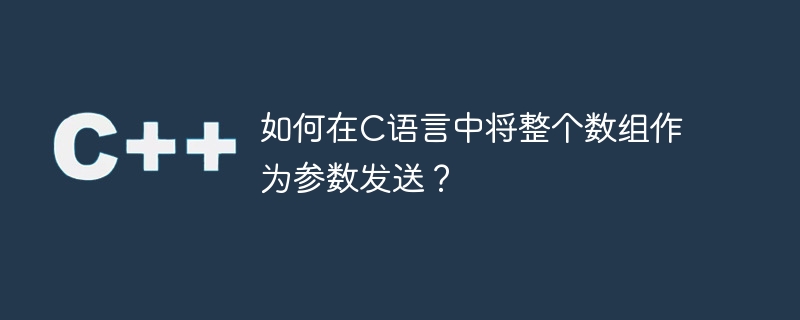

Un tableau est un ensemble d'éléments liés stockés sous un nom commun.
La syntaxe pour déclarer un tableau est la suivante -
datatype array_name [size];
Les tableaux peuvent être initialisés de deux manières, comme suit -
Les tableaux peuvent également être initialisés au moment de la déclaration comme indiqué ci-dessous -
int a[5] = {100,200,300,400,500};Une fonction est un bloc indépendant qui effectue une tâche spécifique bien définie. Les deux méthodes pour passer un tableau en paramètre à la fonction sont les suivantes -
Envoyer le tableau entier en tant que paramètre à la fonction.
Envoyez des éléments individuels en tant que paramètres à la fonction.
Maintenant, comprenons comment envoyer un tableau entier en paramètre pour fonctionner en C.
Pour envoyer un tableau entier en paramètre, essayez d'appeler .
Pour recevoir l'intégralité du tableau, le tableau doit être déclaré dans l'en-tête de la fonction.
Veuillez vous référer à l'exemple donné ci-dessous -
#include<stdio.h>
main ( ){
void display (int a[5]);
int a[5], i;
clrscr( );
printf ("enter 5 elements");
for (i=0; i<5; i++)
scanf("%d", &a[i]);
display (a); // Sending entire array ‘a’ using array name
getch( );
}
void display (int a[5]) {//receiving entire array
int i;
printf ("elements of the array are");
for (i=0; i<5; i++)
printf("%d ", a[i]);
}Lorsque le code ci-dessus est compilé et exécuté, il produit le résultat suivant-
Enter 5 elements 10 20 30 40 50 Elements of the array are 10 20 30 40 50
Ce qui suit est le Programme C, utilisé pour imprimer les éléments d'un tableau dans l'ordre inverse -
#include<stdio.h>
void main(){
//Declaring the array - run time//
int array[5],i;
void rev(int array[5]);
//Reading elements into the array//
printf("Enter elements into the array: ");
//For loop//
for(i=0;i<5;i++){
//Reading User I/p//
printf("array[%d] :",i);
scanf("%d",&array[i]);
}
//Displaying reverse order of elements in the array//
printf("The elements from the array displayed in the reverse order are :");
rev(array); // Sending entire array ‘a’ using array name
getch();
}
void rev(int array[5]){ //receiving entire array
int i;
for(i=4;i>=0;i--){
//Displaying O/p//
printf("array[%d] :",i);
printf("%d",array[i]);
}
}Lorsque le programme ci-dessus est compilé et exécuté, il produit le résultat suivant -
Enter elements into the array: array[0] :23 array[1] :34 array[2] :12 array[3] :56 array[4] :12 The elements from the array displayed in the reverse order are: array[4] :12 array[3] :56 array[2] :12 array[1] :34 array[0] :23
Ce qui précède est le contenu détaillé de. pour plus d'informations, suivez d'autres articles connexes sur le site Web de PHP en chinois!
 Nom des variables en langage C
Nom des variables en langage C
 Auto-apprentissage pour débutants en langage C sans fondement
Auto-apprentissage pour débutants en langage C sans fondement
 Ordre de priorité des opérateurs en langage C
Ordre de priorité des opérateurs en langage C
 Structure de données en langage C
Structure de données en langage C
 Utilisation des fonctions aléatoires du langage C
Utilisation des fonctions aléatoires du langage C
 utilisation du langage c const
utilisation du langage c const
 Utilisation de la fonction get en langage C
Utilisation de la fonction get en langage C
 méthode d'initialisation du tableau c
méthode d'initialisation du tableau c